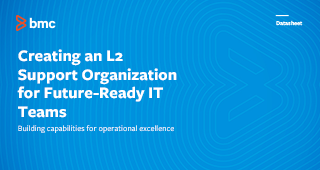BMC Case Study: Increasing IT Efficiency with a Level-2 Support Organization
The evolution of the enterprise IT support organization mirrors that of the impact of technology on the world at large—as innovation drives demand, organizations must scale to both meet those requirements and anticipate further disruption.
The role of IT service (also referred to as technical support, help desk, or service desk, with only slight differences in interpretation) is fairly straightforward: to help users with technology products or services. The IT support organization often rides a line between technical expertise and practical application—specifically, customer service.
The levels of service provided, though, are a source of ongoing conversation and change in most IT organizations today as we seek to reduce costs, improve efficiencies, and deliver an outstanding customer experience. Whereas one might assume a higher level of support would lead to greater user satisfaction, that isn’t necessarily the case—in fact, effective self-help or L0 support, known as being able to solve a problem without outside assistance (and the related burdens of time spent, communication issues, and other complications) is frequently considered the mark of a truly user-friendly service organization. L1 support is essentially a feedback channel, with support agents trained to manage relatively simple issues with previously defined knowledge and call scripts. L3 support, designed to be highly effective and resource-intensive, should be reserved for complex issues that require investigation and often problem duplication.
So where does L2 support come in, and how can it optimize its function as a critical component to service delivery and a value-driver rather than just a cost center?
As companies and departments change to accommodate the innovations and advancements necessary to remain competitive, a balance between engineering and operations that accommodates budget and resource restrictions is mandatory. With the right steps in place, an L2 organization that is enabled with the latest technologies, empowered with digital capabilities, and structured to ensure agility and growth is poised to succeed.
BMC IT took this journey, and in this short blog series, we will describe the priorities we determined for our L2 organization, the process we undertook (including the lessons we learned along the way), and our outcomes. We hope it will serve as an inspiration to your organization as you look to galvanize your service delivery, please your customers, and deliver operational excellence.
Where We Were
When enterprises view IT as a cost center that addresses issues reactively (yet with the expectation that the org will afford innovative tools within their tight budget), IT often reacts by diverting higher-skilled employees into valuable innovation projects without up leveling L1 service providers. With teams segregated under operations and engineering verticals, development and engineering teams are often pulled in to assist overburdened L1. When BMC realized the resulting inefficiencies (and team frustrations), we moved toward creating a dedicated L2 support organization as a part of the core operational group, NOC, and service desk.
Our priorities were clear:
- We wanted to better leverage our skilled employees and existing resources including the processes and technology that our organization relies upon.
- We needed to deliver better service experiences, including the latest technology capabilities for automation and cognitive, to increase customer satisfaction and demonstrate efficiency.
- We planned to ensure better business/IT alignment for reliable SLA outcomes and focused deliverables.
We are now in year four of our journey, and as you will learn in the next two installments, our carefully planned and executed strategy has allowed us to run the business efficiently while reinventing how we deliver our services.
Up Next: To learn more about what prompted BMC IT to take on this challenging yet rewarding process and how your organization might benefit from the same exercise, read the next post in the series, or read the white paper for the full story now.
Creating an L2 Organization for Future-Ready IT Teams
These postings are my own and do not necessarily represent BMC's position, strategies, or opinion.
See an error or have a suggestion? Please let us know by emailing blogs@bmc.com.





